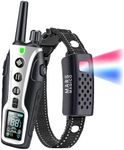Buying Guide for the Best Shock Collars
Choosing the right shock collar for your dog can be a challenging task, but with the right information, you can make an informed decision that ensures the safety and well-being of your pet. Shock collars are used for training purposes, helping to correct unwanted behaviors by delivering a mild electric shock. It's important to understand the key specifications and how they relate to your dog's needs and your training goals. Here are some essential specs to consider when selecting a shock collar.Shock LevelsShock levels refer to the intensity of the electric shock delivered by the collar. This is important because different dogs have different sensitivities, and you want to ensure the collar is effective without being overly harsh. Shock levels typically range from low to high, with some collars offering multiple settings. For smaller or more sensitive dogs, lower shock levels are recommended, while larger or more stubborn dogs may require higher levels. It's crucial to start with the lowest setting and gradually increase if necessary, always monitoring your dog's reaction.
RangeThe range of a shock collar indicates the maximum distance from which the remote can activate the collar. This is important for training in different environments, such as indoors, in the yard, or at the park. Ranges can vary from a few hundred feet to several miles. If you plan to train your dog in large open spaces, a collar with a longer range is beneficial. For home use or smaller areas, a shorter range will suffice. Consider your typical training locations to determine the appropriate range for your needs.
Battery LifeBattery life refers to how long the collar and remote can operate before needing a recharge. This is important for convenience and uninterrupted training sessions. Battery life can vary significantly, with some collars lasting a few days and others several weeks on a single charge. If you plan to use the collar frequently, look for models with longer battery life to avoid constant recharging. For occasional use, shorter battery life may be acceptable. Assess your training frequency to choose a collar with suitable battery longevity.
WaterproofingWaterproofing indicates whether the collar can withstand exposure to water, such as rain or swimming. This is important for dogs that spend a lot of time outdoors or enjoy water activities. Waterproof collars ensure that the device remains functional in wet conditions. Some collars are water-resistant, meaning they can handle light rain, while others are fully waterproof and can be submerged. If your dog is active and often around water, opt for a fully waterproof collar. For indoor or dry environments, water resistance may be sufficient.
AdjustabilityAdjustability refers to the ability to customize the fit of the collar to your dog's neck size. This is important for comfort and effectiveness. Collars typically come with adjustable straps to accommodate different sizes. Ensure the collar can be adjusted to fit snugly but not too tight, allowing for comfortable wear. Measure your dog's neck and check the collar's size range to ensure a proper fit. A well-fitted collar will stay in place and deliver consistent corrections.
Training ModesTraining modes refer to the different types of corrections the collar can deliver, such as vibration, beep, or shock. This is important for versatility in training methods. Some collars offer multiple modes, allowing you to start with gentler corrections like beep or vibration before using shock. This can be helpful for dogs that respond well to less intense stimuli. Consider your dog's temperament and training needs to choose a collar with appropriate modes. Multi-mode collars provide flexibility and can be adjusted as your dog's training progresses.








